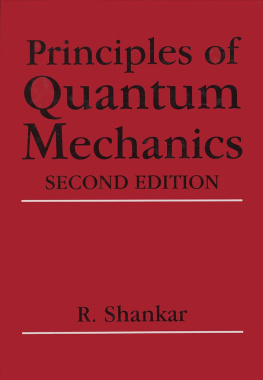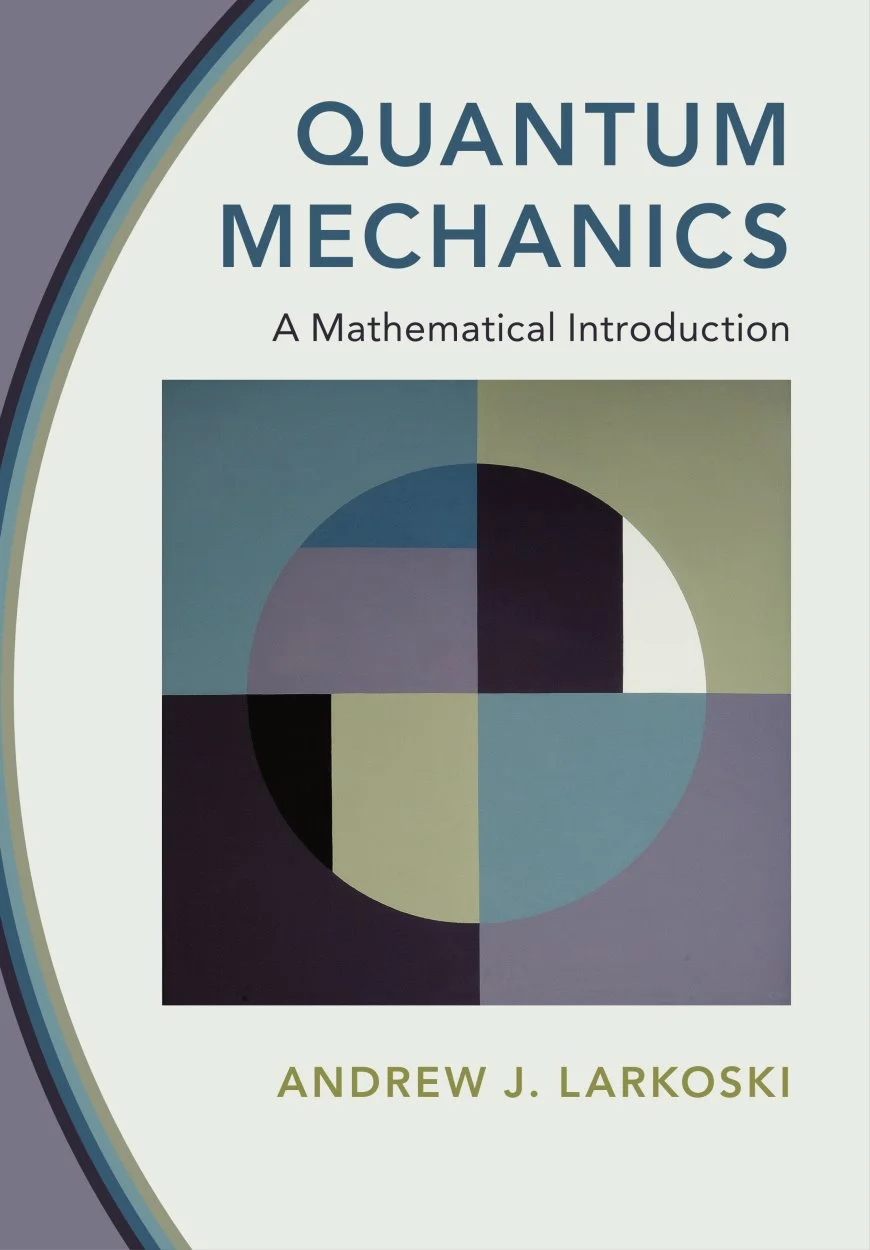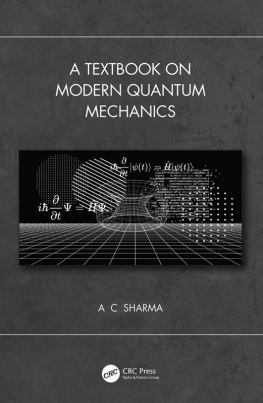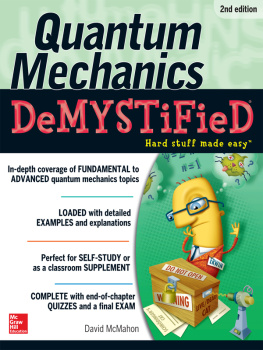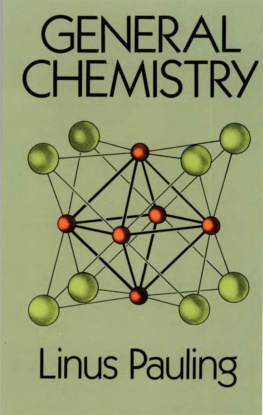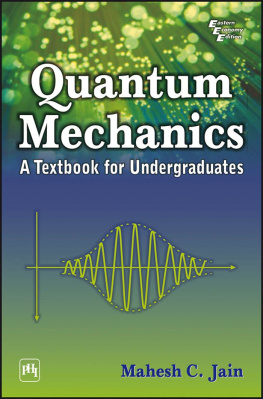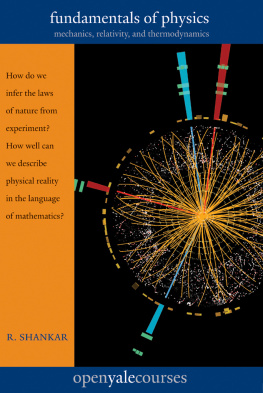Principles of Quantum Mechanics
SECOND EDITION
Principles of Quantum Mechanics
SECOND EDITION
R. Shankar
Yale University
New Haven, Connecticut

Library of Congress Cataloging-in-Publication Data
Shankar, Ramamurti.
Principles of quantum mechanics / R. Shankar. 2nd ed.
p. cm.
Includes bibliographical references and index. ISBN 0-306-44790-8
1. Quantum theory. I. Title.
QC174.12.S52 1994
530.1'2dc20
94-26837
CIP
ISBN 0-306-44790-8
1994, 1980 Springer Science+Business Media, Inc.
All rights reserved. This work may not be translated or copied in whole or in part without the written permission of the publisher (Springer Science+Business Media, Inc., 233 Spring Street, New York, NY 10013, USA), except for brief excerpts in connection with reviews or scholarly analysis Use in connection with any form of information storage and retrieval, electronic adaptation, computer software, or by similar or dissimilar methodology now know or hereafter developed is forbidden.
The use in this publication of trade names, trademarks, service marks and similar terms, even if the are not identified as such, is not to be taken as an expression of opinion as to whether or not they are subject to proprietary rights
19 18 17 16 15 14 13 12 11 10
springeronline.com
To
My Parents
and to
Uma, Umesh, Ajeet, Meera, and Maya
Preface to the Second Edition
Over the decade and a half since I wrote the first edition, nothing has altered my belief in the soundness of the overall approach taken here. This is based on the response of teachers, students, and my own occasional rereading of the book. I was generally quite happy with the book, although there were portions where I felt I could have done better and portions which bothered me by their absence. I welcome this opportunity to rectify all that.
Apart from small improvements scattered over the text, there are three major changes. First, I have rewritten a big chunk of the mathematical introduction in the path integral recipe was simply given, here I start by deriving it. I derive the configuration space integral (the usual Feynman integral), phase space integral, and (oscillator) coherent state integral. I discuss two applications: the derivation and application of the Berry phase and a study of the lowest Landau level with an eye on the quantum Hall effect. The relevance of these topics is unquestionable. This is followed by a section of imaginary time path integrals its description of tunneling, instantons, and symmetry breaking, and its relation to classical and quantum statistical mechanics An introduction is given to the transfer matrix. Then I discuss spin coherent state path integrals and path integrals for fermions. These were thought to be topics too advanced for a book like this, but I believe this is no longer true. These concepts are extensively used and it seemed a good idea to provide the students who had the wisdom to buy this book with a head start.
How are instructors to deal with this extra chapter given the time constraints? I suggest omitting some material from the earlier chapters. (No one I know, myself included, covers the whole book while teaching any fixed group of students.) A realistic option is for the instructor to teach part of I think, would be to lose a wonderful opportunity to expose the student to ideas that are central to many current research topics and to deny them the attendant excitement. Since the aim of this chapter is to guide students toward more frontline topics, it is more concise than the rest of the book. Students are also expected to consult the references given at the end of the chapter.
Over the years, I have received some very useful feedback and I thank all those students and teachers who took the time to do so. I thank Howard Haber for a discussion of the Born approximation; Harsh Mathur and Ady Stem for discussions of the Berry phase; Alan Chodos, Steve Girvin, Ilya Gruzberg, Martin Gutzwiller, Ganpathy Murthy, Charlie Sommerfeld, and Senthil Todari for many useful comments on . I am most grateful to Captain Richard F. Malm, U.S.C.G. (Retired), Professor Dr. D. Schlter of the University of Kiel, and Professor V. Yakovenko of the University of Maryland for detecting numerous errors in the first printing and taking the trouble to bring them to my attention. I thank Amelia McNamara of Plenum for urging me to write this edition and Plenum for its years of friendly and warm cooperation. Finally, I thank my wife Uma for shielding me as usual from real life so I could work on this edition, and my battery of kids (revised and expanded since the previous edition) for continually charging me up.
R. Shankar
New Haven, Connecticut
Preface to the First Edition
Publish and perishGiordano Bruno
Given the number of books that already exist on the subject of quantum mechanics, one would think that the public needs one more as much as it does, say, the latest version of the Table of Integers. But this does not deter me (as it didnt my predecessors) from trying to circulate my own version of how it ought to be taught. The approach to be presented here (to be described in a moment) was first tried on a group of Harvard undergraduates in the summer of 76, once again in the summer of 77, and more recently at Yale on undergraduates (7778) and graduates (7879) taking a year-long course on the subject. In all cases the results were very satisfactory in the sense that the students seemed to have learned the subject well and to have enjoyed the presentation. It is, in fact, their enthusiastic response and encouragement that convinced me of the soundness of my approach and impelled me to write this book.
The basic idea is to develop the subject from its postulates, after addressing some indispensable preliminaries. Now, most people would agree that the best way to teach any subject that has reached the point of development where it can be reduced to a few postulates is to start with the latter, for it is this approach that gives students the fullest understanding of the foundations of the theory and how it is to be used. But they would also argue that whereas this is all right in the case of special relativity or mechanics, a typical student about to learn quantum mechanics seldom has any familiarity with the mathematical language in which the postulates are stated. I agree with these people that this problem is real, but I differ in my belief that it should and can be overcome. This book is an attempt at doing just this.
It begins with a rather lengthy chapter in which the relevant mathematics of vector spaces developed from simple ideas on vectors and matrices the student is assumed to know. The level of rigor is what I think is needed to make a practicing quantum mechanic out of the student. This chapter, which typically takes six to eight lecture hours, is filled with examples from physics to keep students from getting too fidgety while they wait for the real physics. Since the math introduced has to be taught sooner or later. I prefer sooner to later, for this way the students, when they get to it. can give quantum theory their fullest attention without having to battle with the mathematical theorems at the same time. Also, by segregating the mathematical theorems from the physical postulates, any possible confusion as to which is which is nipped in the bud.

